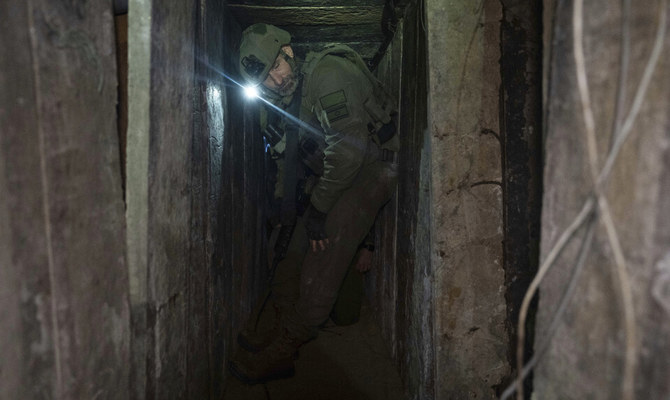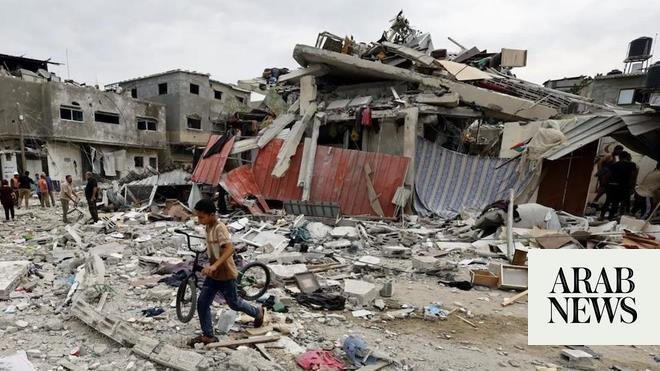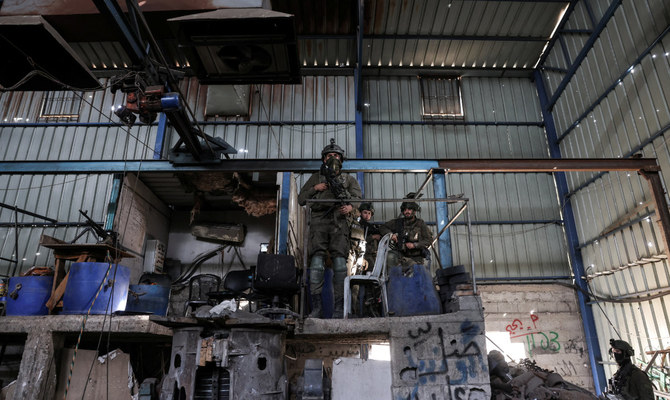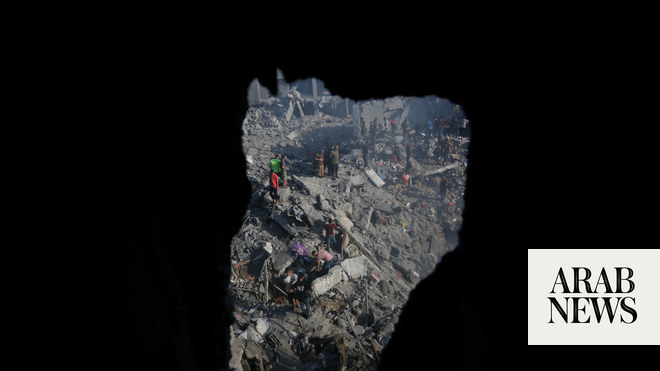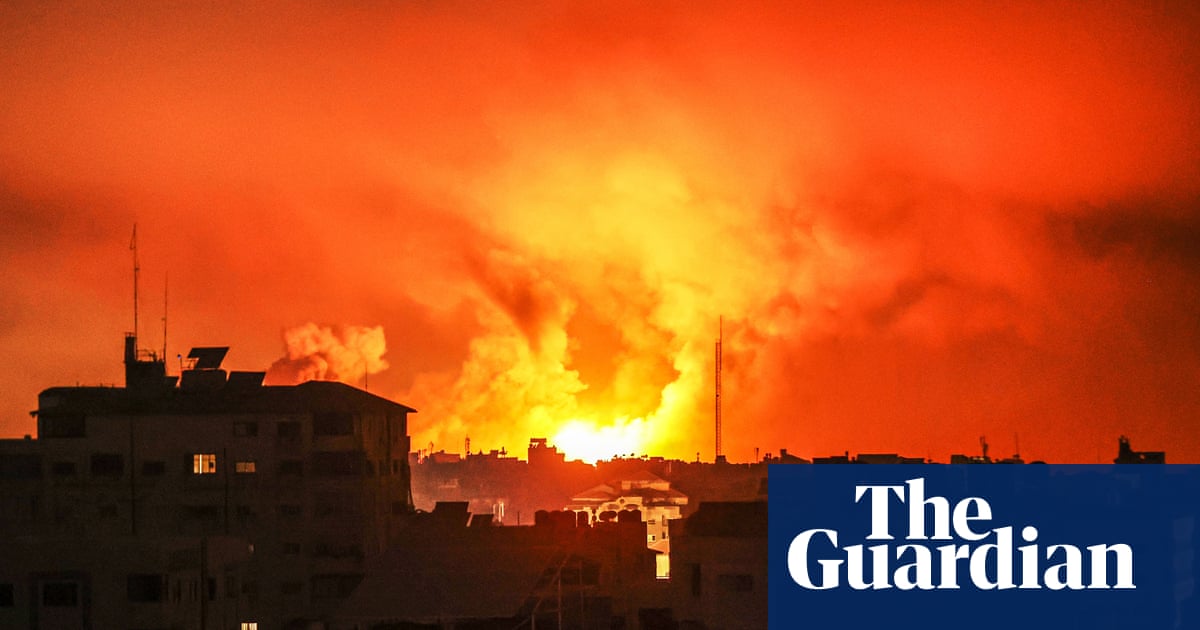
The Israel Defence Forces have said they struck 150 underground Hamas targets in Gaza overnight in the heaviest aerial bombardment of the Gaza war so far, as Palestinian residents of the territory reported clashes with Israeli armoured vehicles and infantry overnight.
According to the IDF, about 100 Israeli jets were involved in the strikes which began in earnest after dusk on Friday.
Video footage released by the IDF on Saturday morning showed columns of tanks crossing a flat and open sandy area of Gaza, firing on built up areas in the distance.
Unlike the previous larger-scale raids that have occurred in recent nights from which Israeli forces withdraw, officials said armour and infantry remained in Gaza on Saturday morning.
“The forces are still on the ground and are continuing the war,” said an IDF spokesperson, R Adm Daniel Hagari, without elaborating.
The intensification of the fighting prompted alarm among families of the 229 hostages being held by Hamas in Gaza. The Hostages and Missing Families Forum demanded an immediate meeting with the prime minister, Benjamin Netanyahu, the defence minister, Yoav Gallant, and members of the war cabinet.
In a statement, the group said: “This night was the worst of all nights. Anxiety, frustration, and especially enormous anger that no one from the war cabinet bothered to meet with the families of the abductees to explain to them one thing – whether the ground operation endangers the safety of the 229 abductees in Gaza.”
With internet and mobile services almost entirely cut off in Gaza from Friday evening, information about the situation in the Hamas-ruled coastal strip of 2.3 million people was scant. Footage from media-camera positions just outside Gaza in Israel and Egypt showed a night of endless airstrikes and artillery colouring the night sky orange.
By Saturday morning Gaza was enfolded in dense fog. Detonations could be heard in the territory intermittently.
An IDF spokesperson said the airstrikes involving 100 Israeli jets hit combat tunnels, underground combat areas and underground terrorist infrastructure.
The handful of reports to emerge from inside Gaza described a chaotic situation, with paramedic teams struggling to coordinate the recovery of the dead and injured because of the lack of communications.
A journalist working for the BBC in Gaza described “total chaos” during the night of strikes and in its aftermath.
“There was a huge bombardment in the north of Gaza Strip on a scale we’ve never seen before,” wrote Rushdi Abualouf.
“At the hospital here, ambulance drivers told me they couldn’t communicate with anyone, so they were just driving in the direction of the explosions.
“There’s been panic everywhere – even here in Khan Younis where the bombing was less – as people try to reach family members in other areas to check they are safe, but the phones have been cut off.”
The armed wing of Hamas said late on Friday its fighters were clashing with Israeli troops in Gaza’s north-eastern town of Beit Hanoun and in the central area of Bureij.
“Netanyahu and his defeated army will not be able to achieve any military victory,” Hamas said in a statement early on Saturday.
The UN general assembly overwhelmingly called for an immediate and sustainable humanitarian truce in Gaza late on Friday. The non-binding vote passed with 120 in favour, while 45 abstained and 14 – including Israel and the US – voted against.
Earlier on Friday, the UN said basic services in Gaza had crumbled, leaving people exposed to major outbreaks of disease as the streets overflowed with sewage, and food, water and medicine ran out.
According to reports from Gaza residents, the heaviest clashes appeared to be taking place in the northern area of Beit Lahia and Beit Hanoun, while clashes were also reported east of the Bureij refugee camp in central Gaza, and east of the southern city of Khan Younis, although it was unclear on what scale. All areas have been used as approach routes for Israeli incursions in the past.
The strikes on the extensive Hamas tunnel system, known colloquially to Israeli military planners as the “metro”, comes after the released hostage Yocheved Lifshitz, 85, said she and other captives were taken deep inside the tunnels during her captivity.
Explosions from continuous airstrikes lit up the sky over Gaza City for hours after nightfall on Friday.
The Palestinian telecom provider, Paltel, said the bombardment caused “complete disruption” of internet, cellular and landline services. This meant that casualties from strikes and details of ground incursions could not immediately be known. Some satellite phones continued to function.
Already plunged into darkness after most electricity was cut off weeks ago, Palestinians were isolated further, huddling in homes and shelters, with food and water supplies running out. Attempts to reach Gaza residents by phone were largely unsuccessful early on Saturday.
Relatives outside Gaza panicked after their messaging chats with families inside suddenly went dead and phone calls stopped going through.
Wafaa Abdul Rahman, the director of a feminist organisation based in the West Bank city of Ramallah, said she had not heard for hours from family in central Gaza. “We’ve been seeing these horrible things and massacres when it’s live on TV, so now what will happen when there’s a total blackout?” she asked, referring to scenes of families that have been crushed in their homes by airstrikes over recent weeks.
The Israeli military spokesperson R Adm Hagari said ground forces were “expanding their activity” on Friday evening in Gaza and “acting with great force … to achieve the objectives of the war”. Israel says its strikes target Hamas fighters and infrastructure and that the militants operate from among civilians, putting them in danger.
The Hamas media centre reported heavy nighttime clashes with Israeli forces at several places, including what it said was an Israeli incursion east of the Bureij refugee camp.
Asked about the report, the Israeli military reiterated on Saturday that it had been carrying out targeted raids and expanding strikes with the aim of “preparing the ground for future stages of the operation”.
Israel has amassed hundreds of thousands of troops along the border ahead of an expected ground offensive. Since mid-week, the military has reported nightly hours-long raids by ground forces into Gaza, saying troops have struck Hamas targets with the aim of preparing the battlefield.
Gallant said Israel expected to launch a long and difficult ground offensive into Gaza soon. It “will take a long time” to dismantle Hamas’s vast network of tunnels, he said, adding that he expected there to be a lengthy phase of lower-intensity fighting as Israel destroyed “pockets of resistance”.
His comments pointed to a potentially gruelling and open-ended new phase of the war after three weeks of relentless bombardment.
Israel has said it aims to crush Hamas’s rule in Gaza and its ability to threaten Israel. How Hamas’s defeat will be measured, and what an invasion’s endgame will look like remain unclear. Israel says it does not intend to rule the territory but does not say who it expects to do so.
In Washington, the Pentagon said the US defence secretary, Lloyd Austin, spoke with Gallant on Friday and “underscored the importance of protecting civilians during the Israel Defence Forces’ operations and focusing on the urgency of humanitarian aid delivery for civilians in Gaza”. The Pentagon said Austin also brought up “the need for Hamas to release all of the hostages”.
The conflict has threatened to ignite a wider war across the region. Arab nations – including US allies and ones that have reached peace deals or normalised ties with Israel – have raised increasing alarm over the potential ground invasion of Gaza, which is likely to increase casualties amid urban fighting.




